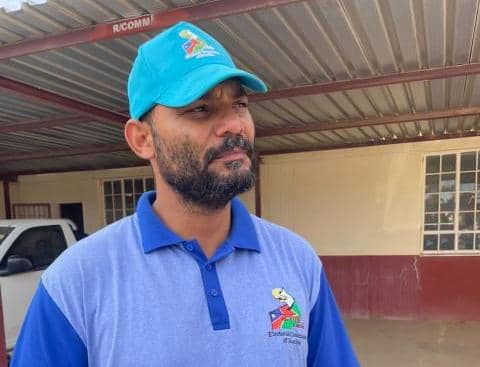FLOODWATERS yesterday started to threaten settlements in the Ngoma area in Caprivi.
A Regional Emergency Management Unit (REMU) team travelled to the area to assess the extent of the flooding and to discuss an appropriate site with traditional indunas to relocate people who will be forced from their homes. Catholic AIDS Action (CAA) reported yesterday that a woman caring for 17 orphans at Masikile, about 15 kilometres from Ngoma, heads one of several vulnerable households in the area about to lose the little they have.According to CAA’s Jane Wachila, the woman is struggling to build a shelter which will be safe.The mainly young girls are unable to provide much help.Meanwhile, evacuation continued in the worst-hit eastern floodplains.Head of delegation from the Prime Minister’s Office, Ndeutapo Amagulu, said yesterday that it had been “a hectic day” trying to move the last residents from Muzii, Mpukano and Nsundwa.Emergency teams have been airlifting people from these villages for three full days.Amagulu estimates that to date about 2 500 people have been taken to designated areas of safety – but he said figures received from various sources were conflicting.Several hundred more people have arrived at these spots – mostly Impalila Island – on their own.Although officials were almost certain that they had moved all people under threat from Itomba some days ago, a baby was born near there on Wednesday.By the time a call for help reached REMU, the woman was already in labour.Although the mother was weak when rescue officials airlifted her to Katima Mulilo yesterday, the baby boy was reportedly in good health.A very sick woman, estimated to be almost 90 years old, also had to be flown to the Katima Mulilo Hospital yesterday.Amagulu said that the waters were moving much faster than anticipated, and this weekend, officials would have to concentrate their efforts in the Ngoma vicinity as the waters stream towards Lake Liambezi.The Zambezi River, as measured at Katima Mulilo, was 6,62 metres yesterday, two centimetres lower than the previous day.”We have been warned, that that doesn’t mean much.We are working as fast as we can to evacuate the east,” said Amagulu, who is preparing for a second wave of flood waters to strike this weekend.As Lake Liambezi begins to fill up, waters are also expected to spread far and wide.Amagulu said officials were already making provisional estimates of the number of people in this area – based on figures at schools of people living nearby to the main centres.They would focus on those likely to be affected by the flooding The CAA said yesterday that the work of their organisation’s volunteers – caring for orphans and sick people – had been gravely affected by the flood situation.The Caprivi has the country’s highest AIDS prevalence rate.As a result, there are thousands of orphaned children, many of whom have no fixed home.The CAA said while many volunteers were upset that they could not reach their charges because of the floodwaters, many also feared losing their own belongings.”Many of them have to paddle by canoe but the volunteers have their own problems and it is difficult to serve our clients,” said Wachila.The humanitarian organisation has estimated that so far volunteers had been unable to reach at least 20 households of either orphans or HIV-AIDS-affected people at Masakile, Lusese, Nakabolelwa, Kasika and Ikaba.The head of a home for 13 orphans at Masakile told the CAA that she feared not being able to travel to receive the grants for the children she cares for.”People thought the floods would pass them.But the movement of the water is faster than the people can move themselves,” said Wachila.The CAA said it was worried that it was also losing contact with its clients in the eastern areas, but hoped to meet soon to determine how many had been displaced.Catholic AIDS Action (CAA) reported yesterday that a woman caring for 17 orphans at Masikile, about 15 kilometres from Ngoma, heads one of several vulnerable households in the area about to lose the little they have.According to CAA’s Jane Wachila, the woman is struggling to build a shelter which will be safe.The mainly young girls are unable to provide much help.Meanwhile, evacuation continued in the worst-hit eastern floodplains.Head of delegation from the Prime Minister’s Office, Ndeutapo Amagulu, said yesterday that it had been “a hectic day” trying to move the last residents from Muzii, Mpukano and Nsundwa.Emergency teams have been airlifting people from these villages for three full days.Amagulu estimates that to date about 2 500 people have been taken to designated areas of safety – but he said figures received from various sources were conflicting.Several hundred more people have arrived at these spots – mostly Impalila Island – on their own.Although officials were almost certain that they had moved all people under threat from Itomba some days ago, a baby was born near there on Wednesday.By the time a call for help reached REMU, the woman was already in labour.Although the mother was weak when rescue officials airlifted her to Katima Mulilo yesterday, the baby boy was reportedly in good health.A very sick woman, estimated to be almost 90 years old, also had to be flown to the Katima Mulilo Hospital yesterday.Amagulu said that the waters were moving much faster than anticipated, and this weekend, officials would have to concentrate their efforts in the Ngoma vicinity as the waters stream towards Lake Liambezi.The Zambezi River, as measured at Katima Mulilo, was 6,62 metres yesterday, two centimetres lower than the previous day.”We have been warned, that that doesn’t mean much.We are working as fast as we can to evacuate the east,” said Amagulu, who is preparing for a second wave of flood waters to strike this weekend.As Lake Liambezi begins to fill up, waters are also expected to spread far and wide.Amagulu said officials were already making provisional estimates of the number of people in this area – based on figures at schools of people living nearby to the main centres.They would focus on those likely to be affected by the flooding The CAA said yesterday that the work of their organisation’s volunteers – caring for orphans and sick people – had been gravely affected by the flood situation.The Caprivi has the country’s highest AIDS prevalence rate.As a result, there are thousands of orphaned children, many of whom have no fixed home.The CAA said while many volunteers were upset that they could not reach their charges because of the floodwaters, many also feared losing their own belongings.”Many of them have to paddle by canoe but the volunteers have their own problems and it is difficult to serve our clients,” said Wachila.The humanitarian organisation has estimated that so far volunteers had been unable to reach at least 20 households of either orphans or HIV-AIDS-affected people at Masakile, Lusese, Nakabolelwa, Kasika and Ikaba.The head of a home for 13 orphans at Masakile told the CAA that she feared not being able to travel to receive the grants for the children she cares for.”People thought the floods would pass them.But the movement of the water is faster than the people can move themselves,” said Wachila.The CAA said it was worried that it was also losing contact with its clients in the eastern areas, but hoped to meet soon to determine how many had been displaced.
Stay informed with The Namibian – your source for credible journalism. Get in-depth reporting and opinions for
only N$85 a month. Invest in journalism, invest in democracy –
Subscribe Now!










